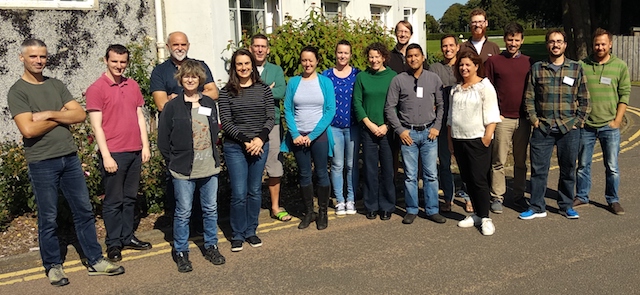Intermediate-level Distance Sampling Workshop
This is the site for the Intermediate-level Distance Sampling Workshop given in St Andrews, 26th to 31st August 2018.

Course materials
- Slides
- Practical session exercises and data
- Materials for the R tutorial
- Bibliography listing additional useful publications
Course description
The first day of the workshop will review fundamental principles of distance sampling, analyses involving conventional distance sampling and survey design. Subsequently, attention will turn to simulation of distance sampling surveys for design purposes, and to survey and analysis methods for dealing with imperfect detection on the trackline (double-observer methods). Slightly more than two days will be devoted to spatial modelling of distance sampling data. A blend of the latest version Distance 7 and the R computing language will be employed. Throughout the workshop, there will be unstructured time, with instructors working with participants on their specific problems.
Schedule
| Day | Purpose | 0900-1030 | 1045-1215 | 1345-1515 | 1530-1700 |
|---|---|---|---|---|---|
| Sunday | (Optional) R refresher/tutorial | R: basics, Rstudio, Practical 1.1 | R: use ds, stratification, MCDS, Practical 1.2 and 1.3 |
R: detections, bootstrapping, Practical 1.4 and 1.5 | R: readdst, Practical 1.6 |
| Monday | Detection functions, DSM introduction | Welcome and review of assumptions | DSM: intro to DSM | DSM: intro to GAMs | DSM Practicals 2, 3: process data, fit detection function, fit DSM, |
| Tuesday | Sperm whale data analysis | DSM: multiple smooths and model selection | DSM: model checking | DSM: Practical 4 (fitting DSMs) and 5 (model selection and diagnostics) | DSM: Prediction and variance estimation |
| Wednesday | DSM wrap-up | DSM: Practical 6 (prediction) and 7 (variance estimation) | DSM: modelling advice and advanced topics | DSM: wrapup | Open |
| Thursday | Double platform detection functions and advanced topics | Mark-recapture distance sampling | MRDS: Practical 8 (mrds), MADS | DSsim: simulation, automated survey design, Practical 9 (Dssim) | Open (selection of special topics) |
| Friday | Research talks and unstructured time | Research talks: acoustics, spatial capture-recapture, other spatial approaches, movement | Special topics | Open | Open |
Refresher of distance sampling concepts
The introductory distance sampling course (previously delivered in St Andrews) is now online for free. Participants should be familiar with these concepts prior to the course.
Software
Participants are encouraged to bring their own laptops to use during the workshop practicals. R and Distance for Windows will be used.
To ensure your computer is setup correctly prior to the workshop please check the instructions below.
Distance for Windows
Distance can be downloaded from the distance sampling website. Distance 7.2 was released 29th June 2018, if you already have Distance on your computer please ensure you have the latest version.
R
The course will use R, RStudio and various R packages to be installed from CRAN. The following steps should setup your computer for the workshop:
- Install R from the R website
- Install RStudio from the RStudio website
- Open RStudio and install R packages using the following command (cut and paste into the Editor window and submit):
install.packages(c("mrds", "Distance", "dsm", "DSsim", "ggplot2", "rgdal", "knitr",
"plyr", "raster", "reshape2", "viridis", "htmltools",
"caTools", "bitops", "rmarkdown", "tweedie", "shapefiles"))
There may be quite a lot of packages downloaded in this process, including many not listed here because the packages listed depend upon many other packages.
Several participants have noted they are unfamiliar with R and RStudio. There are three things that can be done to increase your familiarity.
- For practice with the R language
- DataCamp’s free R tutorial
- Experience using the RStudio interface with R
- DataCamp’s tutorial working with RStudio
- Tutorial prior to the distance sampling workshop
- we will spend Sunday (26th August) working through a tutorial that will be available as part of the workshop practical exercises
ArcGIS
Participants may be interested in the MGET toolbox for ArcGIS for use in data formatting, importing etc. Information on installing the software can be found here, if you already have ArcGIS installed. A brief tutorial is also available on the MGET website.
